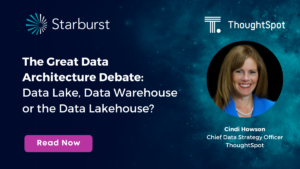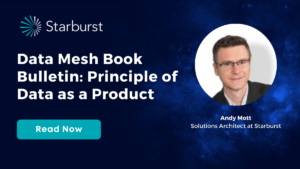Countless hours have been spent trying to achieve the impossible: creating a single source of truth for enterprise data. Inevitably, the complexity of consolidating data from multiple sources turns business analysis into an engineering challenge. Yet, the big data that modern business relies on must be accessible.
7 Challenges of managing and processing distributed data
In the quest for a universal data source, companies have turned from one database management system(DBMS) to another. Data lakes replaced data warehouses. Now, the data lakehouse is emerging and promises the best of both worlds.
These centralized database solutions struggle against the tension between the need for enterprise-wide analysis and the costs of storing high volumes of diverse data in a distributed database system.
Enterprises adopting data-driven cultures need both. The question is, how do you generate higher-quality insights faster while managing the cost and complexity of globally-distributed cloud infrastructures?
Chasing the mythical single source of truth won’t let that happen. Here are seven challenges holding enterprises back.
#1 Data consistency: Fragmentation is the bane of every data team
Data analysis that holistically uses enterprise-wide sources requires consistency levels that single-database systems can’t deliver.
Data analysis teams don’t set company-wide standards for the design of datasets. It’s the operational needs of business units at different sites that decide database structures.
Synchronization becomes a challenge when data structures at every source vary. Properties for similar data will use different file systems, formats or labels, for example. The resulting variation and redundancy complicate query design and makes holistic analysis more difficult than it should be.
#2 Data pipelines: Simply getting the data you need delays any insights a query might deliver
For example, the more unstructured data a query uses, the longer it takes to develop and test its data pipelines.
Once created, these pipelines have to be maintained. Changes in data sources can happen anytime, breaking the pipeline. Moreover, many data sources are real-time streams which asynchronous batch processing cannot handle.
Your company’s data team becomes trapped in a vicious cycle. The more successful they are, the more use cases the team must address, and the more data pipelines these resource-constrained teams must maintain.
Related reading: What is a data pipeline?
#3 Security: Data warehouses and data lakes require enhanced security measures
By definition, they store the information that matters most to the business, making them tempting targets in any cyber attack.
Data access requires strict controls for computer networks and cloud-based apps. However, your data teams must balance the importance of tougher security policies with daily business needs.
#4 Data privacy: Data replication from multiple sources across the enterprise increases your company’s exposure to privacy risk
Consumer or employee personally identifiable information (PII) now exists in two places, doubling and amplifying the chances of security breaches resulting in data loss.
Compounding the problem, your central source of truth allows many more people to link once-isolated data points, increasing the amount of PII exposed in a breach.
Unauthorized access to PII, whether internal or during a breach, could trigger severe penalties under privacy regulations like GDPR and CCPA.
#5 Scaling is resource intensive
Scaling a single source of truth takes time, effort, and money — especially when scaling an on-premises data warehouse. Although cloud services simplify the basics of storage expansion, they do not help with design, testing, and administration.
Even with data lakes, scaling is a challenge. Enterprise data production constantly increases and diversifies. And since operational units change their data storage without consideration for the data team, keeping up-to-date is a continual struggle.
#6 Fault tolerance: Centralization is never a one-and-done action
It’s an ongoing process as fresh data continuously flows into the database.
Systems that do not comply with ACID (atomicity, consistency, isolation, durability) principles, particularly data lakes, can introduce errors should transactions fail.
Fault intolerance can also impact the end users of your analytics database. A network outage or resource constraint may disrupt a query. This failure might frustrate an analyst conducting light research. However, repeated failures of large batch operations could have more significant impacts.
#7 Data integration is a thankless job
Unfortunately, machine learning only gets you so far. Someone has to look at data sources from different domains and map them to how the central data warehouse or data lake works.
Integration requires domain awareness, an understanding of the semantics used at the source and the central data store, skills with specialized tools, and a lot of time.
Without the support and resources data teams need to do integration right, an organization cannot analyze all the data at its disposal.
8 Benefits of an analytics engine for distributed data
Companies can avoid these challenges and frustrations by accepting that monolithic approaches won’t work. Given the complexity and dynamism of modern enterprises, a single source of truth is impossible.
It’s much easier to embrace a federated future. Different data remains where it belongs: at the source.
Starburst’s single point of access lets you generate business insights from distributed data. Benefits of using an analytics engine like Starburst include:
#1 Deploy anywhere
Starburst deploys to any data source, no matter where it is. You can use our SQL query engine to pull data from anywhere whether your data sits in a data center at a physical location or in a cloud, multi-cloud, or hybrid-cloud infrastructure.
Your end users get a more holistic view of the enterprise than with your old data warehouse.
At the same time, you gain complete control over and visibility into your company’s Starburst usage to identify bottlenecks or unusual behavior.
#2 Reduces ETL
Demands from an increasingly data-driven enterprise compete with the proliferation of data pipelines for your team’s already constrained resources. These opaque failure modes of ETL and ELT pipelines don’t help.
Starburst reduces the burden of pipeline management by letting queries automatically recover from errors and generating actionable error messages.
Of course, the easiest pipeline to maintain is one that doesn’t exist. Starburst lets analysts query your data sources directly so your data team won’t need to develop a pipeline for every end user request.
#3 Ecosystem of connectors
Starburst supports an ecosystem of over fifty connectors (and counting) that let you access all enterprise data sources. These connectors dissolve the barriers preventing the holistic analysis of your business.
You can tap into the Trino community’s open-source connectors, but Starburst’s exclusive connectors offer additional performance and security capabilities.
#4 Scalability
Starburst scales with your data needs by truly separating compute and storage. For example, increasing data volumes demand the automation of routine tasks. Starburst’s APIs let you manage processes without user interaction.
Our autoscaling system responds to increased demand by seamlessly adding clusters. As demand falls, we scale down gracefully by allowing machines to finish their work before removing them.
Starburst Enterprise Platform’s high-availability feature automatically switches a cluster to a new coordinator should the original become unavailable.
#5 Performance and flexibility
Starburst is a performant solution for both user-driven exploration and long-running batch queries. By separating storage and compute, our massively parallel SQL engine accelerates queries while reducing infrastructure costs.
Features like advanced caching shift workloads to sources where they can execute more efficiently.
Fault-tolerant capabilities in the Starburst Enterprise Platform buffer data during query processing. These buffers let queries resume after interruptions by resource constraints or network outages.
#6 Optionality
Vendor lock-in is a lesson from the data warehouse era few want to repeat. Whether your preferred cloud provider is AWS, Google Cloud, or Microsoft Azure, Starburst is ready to support you. We also support multi-cloud architectures, enabling you simultaneously query sources on all three platforms from one account.
#7 Security and compliance
Starburst’s security features protect your data and support your organization’s compliance programs. We provide multiple authentication options, from enterprise-grade SSO integrations to certificates.
Role-based and attribute-based policies give you fine-grained user access control at the source, schema, table, column, and row levels.
End-to-end TLS encryption protects data in transit between Starburst and the client. Encryption options are also available for communications between cluster nodes.
Finally, Starburst can generate detailed logs of changes to access control policies and supports real-time usage monitoring.
#8 Fast SQL engine for data lake
Starburst reduces time to insight to minutes by enhancing the massively parallelized capabilities of the open-source Trino SQL query engine. Beneath the hood, Starburst analyzes, plans, and generates a distributed workload that simultaneously loads and processes data.
Besides delivering faster response times, Starburst eliminates the need for analysts to go through the data team. They can quickly access your data lake directly using the BI tools they already know.
Topple the monolith and embrace distributed data
A single database serving as the sole source of enterprise truth is as fanciful as cheap fusion power — a great idea you can sink a lot of time and money into, but it just never happens.
Starburst brings that promise down to earth by creating a single point of access that quickly delivers holistic views of your enterprise data.
Additional resources
- See how online fashion retailer Zalando generated higher-quality insights while reinforcing GDPR compliance.
- Read our Enterprise Security Guide to understand how Starburst protects your most sensitive data.
- Sign up for a free Starburst Galaxy starter account to experience distributed data yourself.








